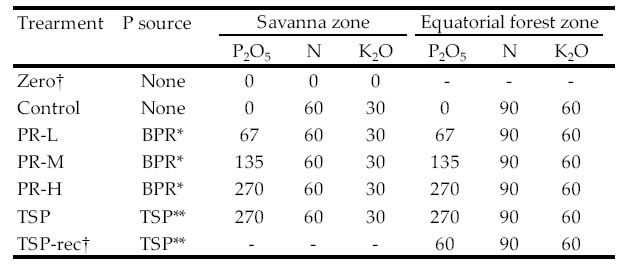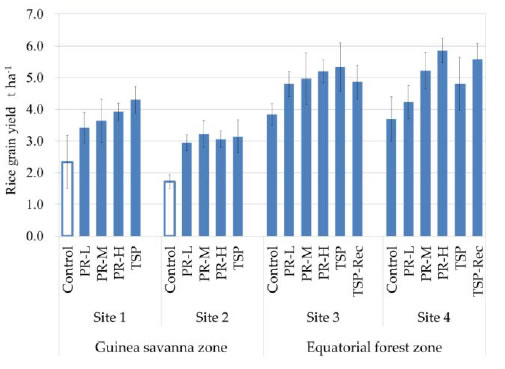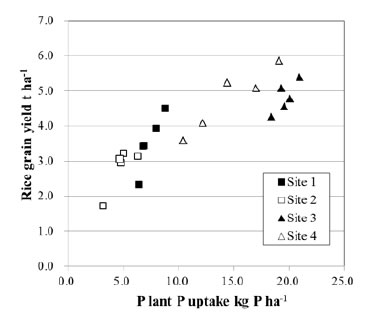Direct application of Burkina Faso phosphate rock is highly effective on lowland rice cultivation
Description
Phosphorus (P) is a critical nutrient for crop production all over the world. In Sub-Saharan Africa (SSA), deficit of soil P is one of the most serious constraints on crop production. This shortfall has resulted from the high P fixation capacities of highly weathered acidic soils. The lack of soil P impacts on a range of agricultural lands, including paddy soils for rice cultivation. However, few farmers in SSA can use commercial water-soluble P fertilizers to cope with this P deficiency. Resource-poor farmers can especially find it difficult to apply these chemical fertilizers because of very limited accessibility and affordability.
Phosphate rock (PR) is considered as the resource that can be an cheaper alternative to water-soluble P fertilizers such as triple super phosphate (TSP). And it was verified that PR deposits are existing in SSA. So it is imperative to propose a proper PR application method with use of local PRs. But generally, PR produced in SSA was considered to have lower effect because of its low solubility, especially on upland crop production.
However, in the direct application on paddy field, it seemed that PR solubility will be affected by its unique soil conditions. So it cannot be denied that PR direct application will show the positive effect on lowland rice production. Elucidation of the effect of PR direct application will be fundamental information for PR utilization in SSA.
This study examined the impact of direct application of fine ground sedimentary PRs produced in Kodjari, Burkina Faso (BPR) on rice production under two agro-ecological conditions of the Guinea Savanna and Equatorial Forest zones of Ghana, with several application levels as shown in Table 1. Effects of BPR direct application on rice grain yield were observed to be comparable to TSP in both agro-ecological zones (Figure 1). In BPR direct application plots, rice grain yield has increased with increase of BPR application rate. These results suggest that BPR direct application is effective on lowland rice production in Ghana. And positive correlation between plant P uptake and rice grain yield has been indicated (Figure 2). It means that applied P has increased rice grain yield effectively. Moreover BPR direct application shows high residual effect on lowland rice production (unpublished data).
Results shown in this study will have great impact on lowland rice cultivation in SSA, because BPR reserve is estimated that 100 million ton (as P2O5) are existing in Burkina Faso, and 600 million tons are estimated in the deposit around Burkina Faso. Moreover, BPR are sold at the 1/4 price against TSP in the marcket in Burkina Faso.
Figure, table
-
Table 1. Summary of fertilizer application rate in each treatment of PR direct application experiment
† In Savanna zone, absolute zero application (Zero) plot was settled, and in Equatorial Forest zone, TSP in recommended rate (60 kg P2O5 ha-1) was set-upped (TSP-rec), respectively.
*BPR: Burkina Faso phosphate rock (P2O5 26%, Ca 32%, Si 6%)
**TSP: Triple Super Phosphate -
Figure 1. Effect of BPR direct application on lowland rice yield in Ghana
Error bars indicate standard error (n=3). Soil pH in each site were as follows, Site1; 5.60, Site 2; 5.83, Site 3; 4.53, Site 4; 5.70. -
Figure 2. Relationship between plant P uptake and rice grain yield under BPR direct application.
Plant P uptake was calculated as multiplication of P concentration in flag leaf determined by dry combution method and above ground biomass.
- Affiliation
-
Japan International Research Center for Agricultural Sciences Crop, Livestock and Environment Division
- Classification
-
Administration A
- Research project
- Program name
- Term of research
-
FY 2013 (FY 2009-FY 2013)
- Responsible researcher
-
Nakamura Satoshi ( Crop, Livestock and Environment Division )
ORCID ID0000-0002-0952-5618KAKEN Researcher No.: 00749921Fukuda Monrawee ( Crop, Livestock and Environment Division )
Tobita Satoshi ( Crop, Livestock and Environment Division )
KAKEN Researcher No.: 30450266 - ほか
- Publication, etc.
-
https://doi.org/10.5897/AJAR12.1830
Nakamura, S.et al. (2013) African Journal of Agricultural Research, 8 : 1779-1789
https://doi.org/10.6090/jarq.47.353Nakamura, S. et al. (2013) JARQ, 47(4): 353-363
Potential Utilization of Local Phosphate Rocks to Enhance Rice Production in Sub-Saharan Africa
- Japanese PDF
-
2013_B03_A3_ja.pdf288.2 KB
2013_B03_A4_ja.pdf400.06 KB
- English PDF
-
2013_B03_A3_en.pdf139.4 KB
2013_B03_A4_en.pdf685.78 KB
- Poster PDF
-
2013_B03_poster.pdf379.56 KB



